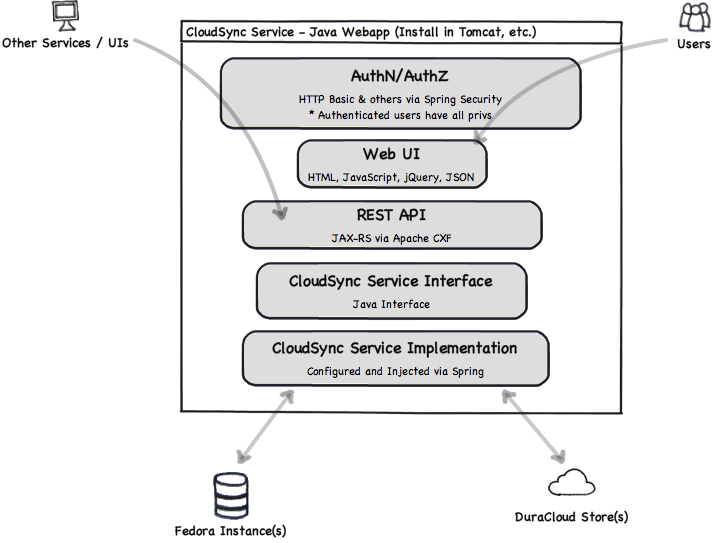
Contents:
High Level Design
Web UI Mockups
All comments (from anyone) are welcome! Please add your comments to the first mockup page listed below, as it represents the latest thinking.
- Fedora CloudSync UI Mockup - 2011-04-19
- Fedora CloudSync UI Mockup - 2011-04-04
- Fedora CloudSync UI Mockup - 2011-03-31
- Fedora CloudSync UI Mockup - 2011-03-29
REST API Design
Introduction
The CloudSync REST API is a web-accessible, resource-oriented API that exposes operations on the key entities of the service:
- Configuration: Properties that affect the global behavior of the application.
- Users: Users that can login to the application. Includes per-user preferences.
- Tasks: Define work that is to be performed or is currently being performed.
- Object Sets: Specifications of groups of Fedora Objects for use with tasks.
- Object Stores: Sources or destinations of Fedora Objects and associated Datastreams.
- System Logs: Raw, text/plain logs of the application. Includes everything except Task Logs.
- Task Logs: Raw, text/plain logs of running or completed tasks.
The exact attributes and representations of these entities have not yet been determined.
The base URL of all REST API operations is the URL of the cloudsync app, plus /api/rest/. For example:
http://example.org/cloudsync/api/rest/
Common MIME Types, Status Codes, and Response Headers
- Unless otherwise stated, requests and responses will always be in JSON or XML format. The default format is XML ("application/xml") unless ".json" is specified at the end of the URL or content negotiation is used to denote a preference for the "application/json" MIME type.
- When GET is used to retrieve information about a resource, success is indicated by a 200 OK response code.
- When POST is used to add a resource (e.g. createTask), a successful (201 Created) response will include a Content-Location header that provides the URI of the new resource. The last portion of that URI will be the newly-allocated id of that resource, which is an opaque, URI-safe string, and the response body will be the representation of the new resource, as if GET had been called on the new URI.
- When PUT is used to update a resource (e.g. updateTask), success is indicated by a 200 OK response code, and the response body will be the updated representation of the resource, as if requested via GET.
- When DELETE is used to remove a resource (e.g. deleteTask), success is indicated by a 204 No Content response code, and the response body will be empty.
Configuration
getConfiguration
GET /cloudsync/api/rest/configuration
updateConfiguration
PUT /cloudsync/api/rest/configuration
Users
createUser
POST /cloudsync/api/rest/users
listUsers
GET /cloudsync/api/rest/users
getUser
GET /cloudsync/api/rest/users/{id}
updateUser
PUT /cloudsync/api/rest/users/{id}
deleteUser
DELETE /cloudsync/api/rest/users/{id}
Tasks
createTask
POST /cloudsync/api/rest/tasks
listTasks
GET /cloudsync/api/rest/tasks
getTask
GET /cloudsync/api/rest/tasks/{id}
updateTask
PUT /cloudsync/api/rest/tasks/{id}
deleteTask
DELETE /cloudsync/api/rest/tasks/{id}
Object Sets
createObjectSet
POST /cloudsync/api/rest/objectsets
listObjectSets
GET /cloudsync/api/rest/objectsets
getObjectSet
GET /cloudsync/api/rest/objectsets/{id}
updateObjectSet
PUT /cloudsync/api/rest/objectsets/{id}
deleteObjectSet
DELETE /cloudsync/api/rest/objectsets/{id}
Object Stores
createObjectStore
POST /cloudsync/api/rest/objectstores
listObjectStores
GET /cloudsync/api/rest/objectstores
getObjectStore
GET /cloudsync/api/rest/objectstores/{id}
queryObjectStore
GET /cloudsync/api/rest/objectstores/{id}/objects[?set={set}&limit={limit}&offset={offset}]
updateObjectStore
PUT /cloudsync/api/rest/stores/{id}
deleteObjectStore
DELETE /cloudsync/api/rest/stores/{id}
System Logs
listSystemLogs
GET /cloudsync/api/rest/systemlogs
getSystemLog
GET /cloudsync/api/rest/systemlogs/{id}
getSystemLogContent
(Returns text/plain content)
GET /cloudsync/api/rest/systemlogs/{id}/content
deleteSystemLog
DELETE /cloudsync/api/rest/systemlogs/{id}
Task Logs
listTaskLogs
GET /cloudsync/api/rest/tasklogs
getTaskLog
GET /cloudsync/api/rest/tasklogs/{id}
getTaskLogContent
(Returns text/plain content)
GET /cloudsync/api/rest/tasklogs/{id}/content
deleteTaskLog
DELETE /cloudsync/api/rest/tasklogs/{id}
Overview
Content Tools
